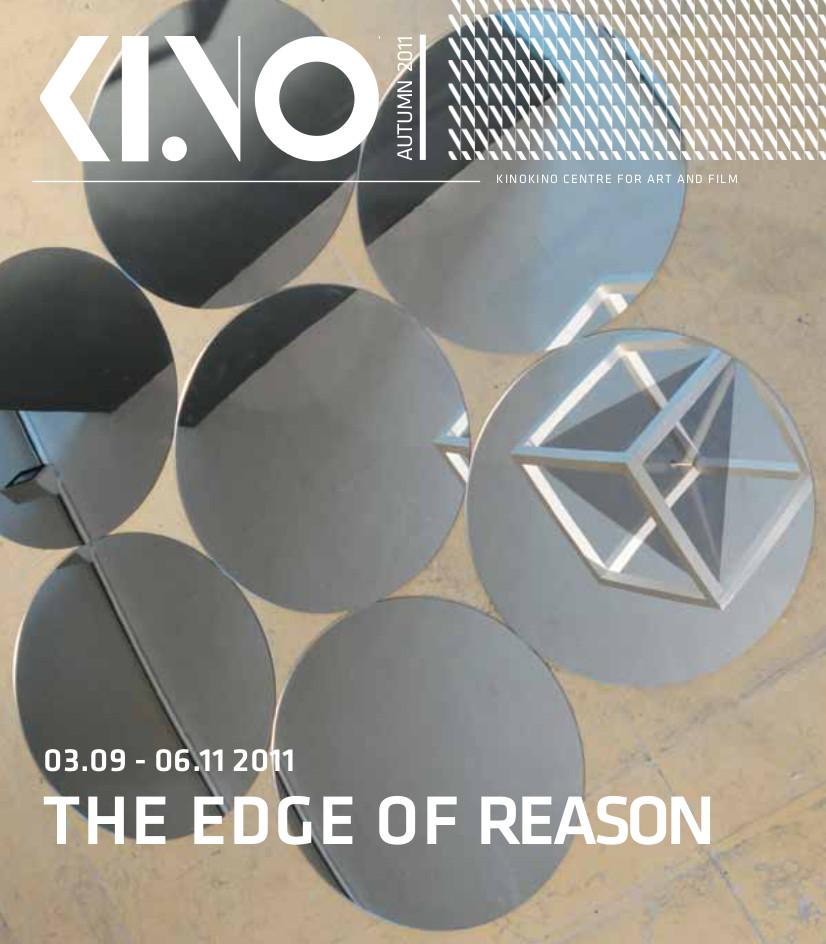The Edge of Reason, catalogue (2011)
Filed under catalogue | Tags: · art, irrational, mysticism, occultism, rationalism, science

The exhibition The Edge of Reason, curated by Norwegian and London-based artists Sidsel Christensen and Ben Judd in 2011 in the KinoKino centre in Sandnes, Norway, explored notions of authenticity and belief, inviting viewer to have a first-hand experience of a world beyond the senses.
Christensen and Judd invited artists whose work helps to trace a historical overlapping in the development of the empirical and scientific with the irrational and mystical. The artists in the exhibition presented a duality of experience, by moving in-between a sceptical enquiry and a more internalised visionary engagement to explore the unknown.
Artists: Sidsel Christensen, Marcus Coates, Maya Deren, George Gurdjieff, Susan Hiller, Ben Judd, Hilma af Klint, Susan MacWilliam, Oscar Muñoz, Karen Russo (with Jeremy Millar, Shezad Dawood, Mark Titchner), Jane and Louise Wilson.
The catalogue contains transcript of a 2011 séance contacting the Swedish pioneer of abstract art and mystic Hilma af Klint (1862—1944; pages 16-23).
Publisher KinoKino Centre for Art and Film, Sandnes, Norway, 2011
56 pages
Michael Kinsella: Legend-Tripping Online: Supernatural Folklore and the Search for Ong’s Hat (2011)
Filed under book | Tags: · conspiracy, fantasy, folklore, internet, mail art, noosphere, occultism, paranormal

“On the Internet, seekers investigate anonymous manifestos that focus on the findings of brilliant scientists said to have discovered pathways into alternate realities. Gathering on web forums, researchers not only share their observations, but also report having anomalous experiences, which they believe come from their online involvement with these veiled documents. Seeming logic combines with wild twists of lost Moorish science and pseudo-string theory. Enthusiasts insist any obstacle to revelation is a sure sign of great and wide-reaching efforts by consensus powers wishing to suppress all the liberating truths in the Incunabula Papers (included here in complete form).
In Legend-Tripping Online, Michael Kinsella explores these and other extraordinary pursuits. This is one of the first books dedicated to legend-tripping, ritual quests in which people strive to explore and find manifest the very events described by supernatural legends. Through collective performances, legend-trippers harness the interpretive frameworks these stories provide and often claim incredible, out-of-this-world experiences that in turn perpetuate supernatural legends.
Legends and legend-tripping are assuming tremendous prominence in a world confronting new speeds of diversification, connection, and increasing cognitive load. As guardians of tradition as well as agents of change, legends and the ordeals they inspire contextualize ancient and emergent ideas, behaviors, and technologies that challenge familiar realities. This book analyzes supernatural legends and the ways in which the sharing spirit of the Internet collectivizes, codifies, and makes folklore of fantastic speculation.”
Publisher University Press of Mississippi, 2011
ISBN 1604739843, 9781604739848
208 pages
review (David J. Puglia, Journal of Folklore Research)
review (Óli Gneisti Sóleyjarson, Folklore)
Legend tripping at Wikipedia
Henrik Bogdan, Martin P. Starr (eds.): Aleister Crowley and Western Esotericism (2012)
Filed under book | Tags: · esotericism, magick, mysticism, occultism, occultural studies, religion, sexuality

Henrik Bogdan and Martin P. Starr offer the first comprehensive examination of one of the twentieth century’s most distinctive occult iconoclasts. Aleister Crowley (1875-1947) was a study in contradictions. He was born into a Fundamentalist Christian family, then educated at Cambridge where he experienced both an intellectual liberation from his religious upbringing and a psychic awakening that led him into the study of magic. He was a stock figure in the tabloid press of his day, vilified during his life as a traitor, drug addict and debaucher; yet he became known as the perhaps most influential thinker in contemporary esotericism.
The practice of the occult arts was understood in the light of contemporary developments in psychology, and its advocates, such as William Butler Yeats, were among the intellectual avant-garde of the modernist project. Crowley took a more drastic step and declared himself the revelator of a new age of individualism. Crowley’s occult bricolage, Magick, was a thoroughly eclectic combination of spiritual exercises drawing from Western European ceremonial magical traditions as practiced in the nineteenth-century Hermetic Order of the Golden Dawn. Crowley also pioneered in his inclusion of Indic sources for the parallel disciplines of meditation and yoga. The summa of this journey of self-liberation was harnessing the power of sexuality as a magical discipline, an instance of the “sacrilization of the self” as practiced in his co-masonic magical group, the Ordo Templi Orientis. The religion Crowley created, Thelema, legitimated his role as a charismatic revelator and herald of a new age of freedom under the law of “Do what thou wilt.”
The influence of Aleister Crowley is not only to be found in contemporary esotericism-he was, for instance, a major influence on Gerald Gardner and the modern witchcraft movement-but can also be seen in the counter-culture movement of the late 1960s and early 1970s, and in many forms of alternative spirituality and popular culture. This anthology, which features essays by leading scholars of Western esotericism across a wide array of disciplines, provides much-needed insight into Crowley’s critical role in the study of western esotericism, new religious movements, and sexuality.
Publisher Oxford University Press, 2012
ISBN 0199863091, 9780199863099
406 pages

